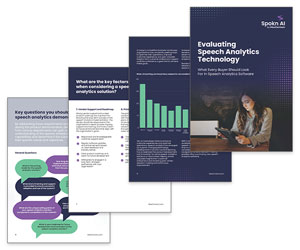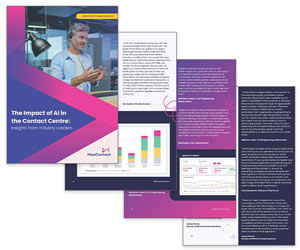In a poll of IT leaders carried out for MaxContact in August 2023, 99% of respondents said they were planning to invest in digital transformation over the next 12 months.
So it’s clear this is an area of focus, but what are their priorities, and – in a challenging economy – what will they spend limited IT budgets on? In addition, what barriers do they face as they look to drive digital transformation plans forward?
Our research revealed lots of interesting insight for IT leaders, and you can read the full report here.
In the rest of this article, we’ll summarise the key findings.
Chasing Operational Efficiency
Nearly half of our respondents (48.98%) said they plan to invest in business operations software over the next 12 months.
That ties in with a general push towards operational efficiency as economic uncertainty persists.
Organisations have subtly shifted their priorities away from more general innovation and towards a more targeted goal of streamlining operations, to reduce cost.
At 42.86%, customer support technologies were the next most popular choice, followed by digital marketing and sales tools.
IT leaders understand that operational efficiency is the result of several connected factors, and streamlined customer support and sales are essential to an organisation’s smooth operation.
The Path to Digital Transformation
What of digital transformation? Digital transformation is the integration of digital technology into every area of a business.
The good news from our survey is that 50% of respondents said their organisations have largely transitioned to digital ways of working. A further 35% say they have a ‘digital-first’ philosophy.
That’s positive because it suggests that, in most cases, wider digital transformation efforts haven’t been entirely sacrificed to reduce costs.
It’s up to IT leaders to convince CEOs and MDs that digital transformation, done properly, is one of the surest paths to cost efficiency. Digital-first businesses tend to be more agile, scalable and productive than less advanced competitors.
Despite that, our survey revealed that a significant minority of respondents (16%) have some way to go before they reach digital maturity.
Some are still in the planning stage, and a few are yet to even consider their wider digital strategy. They may be OK right now, but a head-in-the-sand approach to technology is not sustainable in the long run.
Barriers to New IT Adoption
Digital transformation is an ongoing process, not a one-off shift. Digital-first businesses are always looking to the innovation horizon, keeping an eye on any emerging technology that might improve efficiency, enhance customer experience or drive employee satisfaction.
But our respondents are running into obstacles as they look to swap out underperforming software or implement new digital ways of working.
Over a quarter (26%) see a barrier in the effort involved in implementation, and a fifth (20%) cited a fear of change and its impact on processes and workflows. A further 19% were concerned about costs.
There are clearly roadblocks on the path to digital transformation, including internal resistance to change, security concerns and poorly planned or communicated implementation.
IT leaders need to remove these roadblocks carefully to achieve their goals. Communication is key.
Nurture partnerships with internal stakeholders and external providers, measure change and keep the wider business abreast of the positive impact digital transformation is having.
AI Can Accelerate Digital Transformation
IT leaders can use the excitement over the recent emergence of generative AI to push the case for digital transformation in their organisations.
AI has the potential to be a business game-changer. It makes data useful in ways that have only previously been touched upon. Our research found that IT leaders are already seeing an impact from the deployment of AI-driven tools.
The largest number (32%) are seeing AI drive innovation and digital transformation. That should come as no surprise. AI’s ability to source and analyse mountains of data makes it easier to automate scores of previously manual tasks, creating speed and agility.
A quarter of respondents (25%) are seeing AI’s impact in better customer service and support. Again, that makes perfect sense.
To take just one example, AI-driven chatbots can do more of the mundane work of customer service and support, giving human employees the time to focus on more complex or sensitive cases.
AI is also helping IT leaders streamline processes and improve operational efficiency, and only 6% of our respondents said AI had not affected their role at all.
Having said that, many IT leaders face challenges around integrating AI into current technology stacks, and are looking to vendors to do the heavy lifting in this respect and incorporate AI tools into the solutions organisations already use.
Challenge and Opportunity for IT Leaders
All of this adds up to a combination of tricky challenges and enticing opportunities for IT leaders.
In our survey, over a quarter (26%) said their biggest challenge was managing a hybrid or remote workforce, which says something about the fundamental change in working models since the pandemic.
The same number – 26% – said controlling and optimising costs was their main concern. The instinct to squeeze more from less is entirely understandable in uncertain economic times.
Other challenges were the hardy perennials of an IT leader’s lot: security and data protection (18%) and stakeholder management (17%).
But these priorities also offer opportunities for improvement. Business leaders may be amenable to new technology investment if IT leaders can persuade them that the outcome will be improved efficiency and longer term cost savings.
That appears to be the focus. When we asked respondents what their priorities were in the short and medium term, the number one choice was implementing technology that would improve efficiency.
It was followed by improving data security, optimising the IT budget and improving the customer experience.
It’s notable that IT leaders are being proactive, despite economic constraints. They understand that the key to future resilience is an improved technology stack, one that can create streamlined organisations while also improving customer experience.
With the AI revolution just beginning, many know that this is not the time to rely on legacy tools and applications. There may be bumps in the road, but the journey to digital transformation is one every organisation can benefit from.
This blog post has been re-published by kind permission of MaxContact – View the Original Article
For more information about MaxContact - visit the MaxContact Website
Call Centre Helper is not responsible for the content of these guest blog posts. The opinions expressed in this article are those of the author, and do not necessarily reflect those of Call Centre Helper.
Author: MaxContact
Published On: 2nd Nov 2023 - Last modified: 9th Dec 2024
Read more about - Guest Blogs, MaxContact






 MaxContact is customer engagement software that goes above and beyond to build smarter customer experiences. Our platform is packed with powerful features, accessible for businesses large and small, and ensures organisations can operate compliantly.
MaxContact is customer engagement software that goes above and beyond to build smarter customer experiences. Our platform is packed with powerful features, accessible for businesses large and small, and ensures organisations can operate compliantly. 































